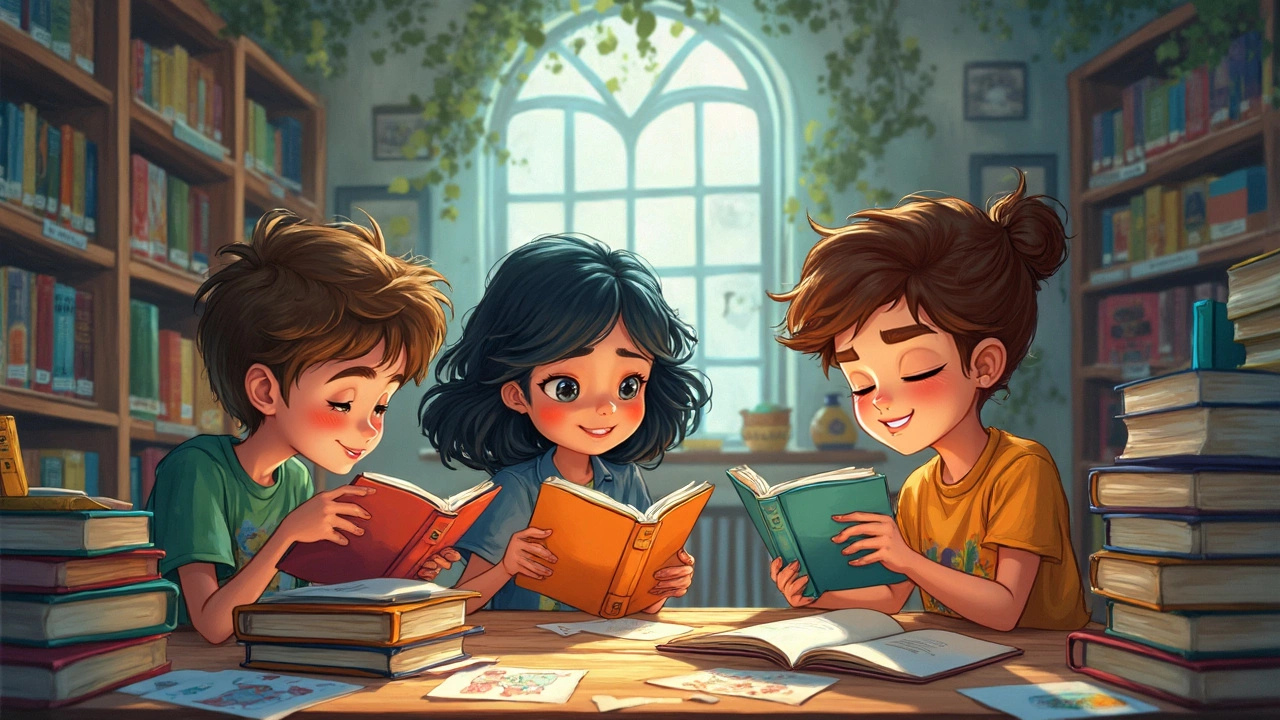Discovering the Difference: Juvenile Fiction vs YA
 Feb, 16 2025
Feb, 16 2025
If you've ever browsed a bookstore or library, you might have noticed the shelves labeled for juvenile and YA books. They cater to a younger crowd, sure, but they're not exactly the same. Wondering how they differ? Let's break it down.
Juvenile fiction typically appeals to kids ages 8 to 12. It's about characters they can relate to at their own age, diving into adventures and challenges that mirror their world but are often set in exciting, imaginative scenarios. Think of series like 'Harry Potter' when it starts—simple, relatable yet packed with enchantment.
On the flip side, YA fiction is aimed at teens, usually 13 to 18, and leans into more complex themes. These stories delve deeper into the emotional and social issues teenagers face, often adding layers of intrigue, romance, and sometimes even conflict that parallels real-life experiences a bit more closely. 'The Hunger Games' is a classic example of this dynamic storytelling.
Understanding these differences isn't just useful for writers or publishers; it's super handy for readers too. Picking up a book that's right for you or your kid can make all the difference in enjoying the read. So, let's unravel these genres a bit more to help you choose the perfect book next time you're in the mood for a good story.
- Understanding Juvenile Fiction
- The World of Young Adult (YA) Fiction
- Difference in Themes and Complexity
- Target Audience Age Groups
- Choosing the Right Genre for Readers
Understanding Juvenile Fiction
What exactly is juvenile fiction, and why is it so appealing to younger readers? At its core, this genre is designed for kids around 8 to 12 years old. It's a time when their imaginations are running wild, and they're keen on stories that whisk them away to other worlds. But what makes those stories stand out?
Elements of Juvenile Fiction
These books typically feature young protagonists, making it easier for kids to see themselves in the characters. Think of how relatable it might be to follow a kid just like them, getting caught up in extraordinary escapades!
- Imaginative settings: From magical lands to time-traveling adventures, the settings in juvenile fiction are vast and varied, encouraging creativity and curiosity.
- Simple yet engaging plots: The stories often focus on friendship, adventure, and mild challenges, building up excitement without overwhelming young minds.
- Positive themes: Life lessons about kindness, bravery, and perseverance are commonly woven into the narrative, making every read a valuable experience.
Examples and Fun Facts
Who hasn't heard of classics like 'Charlotte's Web' or 'Percy Jackson and the Olympians'? These books have enchanted readers for years and stand as perfect examples of well-crafted juvenile fiction. Believe it or not, the juvenile fiction market was worth billions—and that figure keeps growing.
Frequently Asked Questions
Let's tackle some of the common queries about juvenile fiction:
- Can complex themes be part of juvenile fiction? While complexity is limited, themes are thoughtfully presented in a way that's easy for kids to digest.
- Do all juvenile fiction books have moral lessons? Not necessarily, but many do sneak in those valuable life lessons in subtle ways!
In summary, juvenile fiction is a world full of wonder waiting for young readers to explore, promising fun while fostering learning and imagination.
The World of Young Adult (YA) Fiction
YA fiction, short for Young Adult fiction, is pretty much the go-to for teenagers looking to see their experiences mirrored in literature. At its core, YA is all about that sweet spot where relatability meets entertainment. These books deal with themes that echo the whirlwind of adolescent life, from first loves to finding out who you are.
Let's look into the characters and themes. In YA, you'll find protagonists typically aged 13 to 18. These characters are navigating life and facing conflicts—think parents, first crushes, peer pressure, or discovering their identity. Those issues aren't just random; they're pivotal in shaping young minds.
Themes That Resonate
Themes in YA books often include coming-of-age, identity, and empowerment. There's a strong sense of self-discovery, as characters learn about themselves and others. Why is this so captivating? Because it mirrors the reader's life. Whether it's Katniss Everdeen fighting for survival in 'The Hunger Games' or Hazel Grace navigating love and illness in 'The Fault in Our Stars,' these stories hit home.
To give you a sense of popularity, here's a little stat:
| Year | Top YA Book |
|---|---|
| 2023 | 'One of Us Is Lying' |
| 2024 | 'They Both Die at the End' |
The Influence of YA Fiction
YA fiction isn't just popular among teens; adults read these books too. Remember the 'Harry Potter' boom? Many readers who grew up with it still find comfort in the relatable stories and imaginative worlds. YA books often break boundaries, exploring far-reaching genres like dystopian, fantasy, and even speculative fiction.
So what makes a YA book stand out? It's the authentic voice that speaks directly to its audience. It's seeing those shared experiences and saying, "Yeah, I get that." It's the blend of intense emotions, crucial life lessons, and just enough drama to keep you hooked.

Difference in Themes and Complexity
When it comes to juvenile fiction and YA fiction, understanding the difference in their themes and complexity can help demystify why certain books resonate more with different age groups. It's not just about the age of the reader, but rather how they connect with the story's core.
Juvenile Fiction Themes
Juvenile fiction often revolves around straightforward themes that kids can grasp easily. These might include friendship, adventure, or overcoming a challenge. Characters typically solve problems that align with a middle-schooler's real-world experiences, which helps young readers relate and stay engaged.
YA Fiction Themes
YA fiction, in contrast, dives into deeper waters. Think of themes like identity, love, and rebellion. These books often showcase the transition from childhood to adulthood, examining complex socio-emotional landscapes. They reflect the tumultuous journey of change many teenagers experience, covering ups, downs, and everything in between.
Level of Complexity
In terms of complexity, juvenile fiction tends to keep it simple with clear, concise language and a linear storyline. This helps maintain the attention of younger readers who may still be building their reading stamina.
Meanwhile, YA fiction often weaves layers of subplots, intricate character development, and diverse perspectives. It's not uncommon for YA books to tackle heavy topics like mental health or societal issues, providing teen readers with insight and a sense of connection to their own experiences.
Examples and Real-World Impact
For instance, take the book 'Wonder' by R.J. Palacio—a great example of juvenile fiction that teaches empathy through the eyes of a young protagonist. In the YA realm, John Green's 'The Fault in Our Stars' delves into love and mortality, presenting a complex emotional narrative that captivates older teens.
Choosing the right theme complexity means considering the reader's readiness to process those themes. As readers transition from one genre to the other, they find themselves facing new, thought-provoking perspectives that fit their growing understanding of the world.
Target Audience Age Groups
When diving into juvenile fiction and YA fiction, knowing who these books are meant for can really help you understand their essence. Both categories aim at different stages in young readers' lives, shaping their engagement differently.
Juvenile Fiction Audience
The target for juvenile fiction is usually kids aged 8 to 12. These readers are in a sweet spot where they crave adventure and are curious about the world but still enjoy a bit of fantasy and fun. They're transitioning from picture books to chapter books, looking for stories that match their rapidly growing imaginations. Adventures like those in 'Percy Jackson' draw them in because they balance excitement with relatable challenges, like school or friendships.
Young Adult Fiction Audience
Meanwhile, YA fiction speaks to teens from ages 13 to 18, although the appeal can sometimes extend into the early twenties. These readers are navigating significant changes—emotionally, socially, and physically. Books in this category often deal with more intense and realistic themes such as identity, love, and personal growth, addressing concerns that resonate deeply as teens look for reflections of themselves in what they read. Think of titles like 'The Fault in Our Stars' that portray emotional depth.
Here's a quick look in table format to see how these groups line up:
| Category | Age Group | Themes |
|---|---|---|
| Juvenile Fiction | 8-12 years | Adventure, Friendship, Growing up |
| YA Fiction | 13-18 years | Identity, Love, Real-life Issues |
So, whether you're picking a book for yourself or someone else, knowing the age group helps you hit the right note and ensures the book's themes are both relatable and appropriate.

Choosing the Right Genre for Readers
Figuring out which genre is right for you or your little one isn't just about age—it's more about interests and maturity levels too. Let's break it down on what to consider when picking between juvenile fiction and YA fiction.
Consider the Reader's Age and Interests
For younger kids, those aged 8 to 12, they're often more drawn to stories filled with adventure and fun rather than the drama of real-world problems. Look for books that focus on friendships, simple challenges, and fantastic adventures. Series like 'Percy Jackson' fit the bill nicely.
Teens, on the other hand, are generally more inclined towards young adult themes featuring stronger character development and more complex social issues. Books like 'Divergent' don't shy away from exploring identity, independence, and ethical conundrums.
Maturity Level Matters
It goes without saying that not all kids of the same age have the same emotional maturity. Some children as young as 10 might be ready to dive into lighter YA books, while some 14-year-olds might still enjoy the simplicity of juvenile fiction. You know yourself (or your kid) best, so trust that instinct.
Genre Preferences
We all have certain genres we gravitate towards. Whether it's fantasy, mystery, or dystopian settings, both juvenile and YA fiction offer a range to choose from. Help your reader explore these different styles to find what sparks interest.
Start with the Classics
If you're unsure where to start, consider going for the tried-and-true books. Classics like 'The Chronicles of Narnia' for younger audiences or 'Twilight' for teens can be a great entry point into the world of fiction for readers of any preference.
Don't Overlook the Power of Reviews
Book reviews can offer insight into what themes and issues a book tackles. They can be invaluable when deciding if a book's content is appropriate and engaging for the reader's age and maturity level. Check online platforms, libraries, or even community forums for opinions.
There's no one-size-fits-all when it comes to choosing a genre. It ultimately comes down to what resonates with the reader. Whether it's the imaginative worlds of juvenile fiction or the deeper tales of YA fiction, the right book is out there, ready to make a memorable impact.